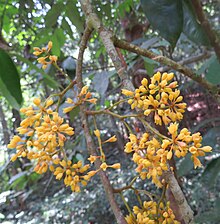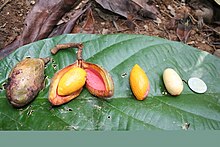Nutmeg family
| Nutmeg family | ||||||||||||
|---|---|---|---|---|---|---|---|---|---|---|---|---|

Nutmeg tree ( Myristica fragrans ) |
||||||||||||
| Systematics | ||||||||||||
|
||||||||||||
| Scientific name | ||||||||||||
| Myristicaceae | ||||||||||||
| R.Br. |
The nutmeg family (Myristicaceae) are a plant family in the order of the magnolia-like (Magnoliales). It includes about 18 to 21 genera with about 475 to 500 species. The best known species of this family is the nutmeg tree ( Myristica fragrans ). In addition to this aromatic plant, there are also species that provide raw materials for the perfume industry .
description
Appearance and leaves

The species of nutmeg grow as evergreen , woody plants: almost always trees or rarely lianas . Only some Virola species are deciduous. The wood is reddish. You have sieve tube plastids of the S type. The plants contain colored, mostly red, sap, especially in the bark or around the heartwood . All parts of the plant contain essential oils . The terminal buds are usually long.
The alternate and spiral or mostly two-line arranged leaves are divided into petiole and leaf blade. The petioles are usually short. The simple and leathery leaf blades are pinnate. The underside of the leaf is often bluish. The leaf margin is smooth. Stipules are missing.
Generative characteristics
Nutmeg plants are rarely monoecious ( monoecious ) or mostly dioecious ( dioecious ) of separate sexes. The flowers are in very differently structured inflorescences ( cymes , coils , grapes or heads ) with bracts . The small, unisexual, mostly threefold flowers have a spiral structure, i.e. not whorled , yet more or less radial symmetry . They usually have only three (two to five) fused bloom cladding sheets . The male flowers rarely contain two, usually three to 30, fertile stamens , but no rudiments of a gynoeceum . The stamens have grown together to form a tube or a discus. The tetrasporangiat dust bag are fused with the tube filament to form a ring or are free. There is only one upper carpel per female flower with only one ovule , but no rudiments of an androeceum .
The mostly very large fruit is fleshy to not fleshy (if not fleshy then it is leathery) and lonely ; it usually opens with two flaps. The large seeds have a fleshy, often very colored aril , which is also used in the nutmeg tree ( Myristica fragrans ). The endosperm usually contains a lot of oil. The well-differentiated embryo is very small. There are two cotyledons ( cotyledons formed), which are sometimes fused at their base.
Occurrence and history of development
The spread of the family is pantropical . South America and Africa are centers of biodiversity. Most of the species are found in the lowland rainforest.
Myristicacarpum chandlerae is the earliest fossil record of a seed from the Myristicaceae family. The find comes from the Early Eocene of the London Clay flora of southern England, so it was found in clay deposits. The origin of the family isbelieved to bein the northwestern Gondwana continent. Although the earliest records (fossils and pollen) are around 21 to 15 million years old, the splitting off from the related taxa of the Magnoliales probably took place 84 to 57 million years ago. The most original recent taxa occur today in Madagascar ( Brochoneura , Mauloutchia ).
Systematics



The Myristicaceae family was established in 1810 by Robert Brown in Prodromus Florae Novae Hollandiae , p. 399. Type genus is Myristica Gronov.
In the nutmeg family (Myristicaceae) there are 18 to 21 genera and 475 to 500 species:
-
Bicuiba W.J. de Wilde : It contains only one species:
- Bicuiba oleifera (Schott) WJ de Wilde : It is common in Brazil .
- Brochoneura Warb. : The three or so species only occur in Madagascar .
-
Cephalosphaera Warb. (Note: there are in zoology also Cephalosphaera Enderlein , a genus of Pipunculidae within the Diptera (Diptera)). The plant genus contains only one species:
- Cephalosphaera usambarensis (Warb.) Warb. : It is common in tropical Africa .
-
Coelocaryon Warb. : Distributed with three to seven species in tropical Africa.
- Coelocaryon preussii Warb. : From central to western Africa.
- Compsoneura (A.DC.) Warb. : Of the nine to eleven species in the Neotropic , seven are only distributed in South America, the others also extend to Central America.
-
Doyleanthus Sauquet : It contains only one species:
- Doyleanthus arillata Capuron ex Sauquet : This endemic occurs in Madagascar only in the Antsiranana province.
- Endocomia W.J. de Wilde : The fouror sospecies are distributed from southern China to New Guinea .
- Gymnacranthera (A.DC.) Warb. : The approximately 17 species are common in Indomalesia .
-
Haematodendron Capuron : it contains only one species:
- Haematodendron glabrum Capuron : In Madagascar it only occurs in the provinces of Mahajanga and Toamasina .
- Horsfieldia Willd. : The approximately 100 species are distributed from Indomalesia to Australia .
- Iryanthera (A.DC.) Warb. : The 20 or so species are common in tropical South America .
- Knema Lour. : The 95 or so species are common in Indomalesia.
- Maloutchia (Baill.) Warb. : The nine or so species only occur in Madagascar .
-
Nutmeg trees ( Myristica Gronov. ): The approximately 175 species are distributed from tropical Asia to Australia, including:
- Nutmeg tree ( Myristica fragrans Houtt. )
-
Osteophloeum Warb. : It contains only one type:
- Osteophloeum platyspermum (Spruce ex A.DC.) Warb. : It thrives in the Amazon.
- Otoba, DC. H. Karst. : The eight to nine species are common in the Neotropic, mainly in northeastern South America.
-
Paramyristica W.J. de Wilde : It contains only one species:
- Paramyristica sepicana (Foreman) WJ de Wilde : It occurs in New Guinea .
-
Pycnanthus Warb. : The three to six species are common in tropical Africa, including:
- Pycnanthus angolensis (Welw.) Warb. : The home is Angola .
- Scyphocephalium Warb. : The three to four species are common in tropical Africa.
- Staudtia Warb. : The two to four species are common in tropical Africa.
-
Virola Aubl. : The 40 or so species are found in the Neotropics, mainly in South America, including, for example:
- Tallow nutmeg tree ( Virola sebifera Aubl. ): It is common in Central and South America.
- Virola surinamensis Warb. : It is common on islands in the Caribbean, Costa Rica and northern South America.
swell
- The Myristicaceae family on the AP website. (Sections Description and Systematics)
- Description of the family Myristicaceae at DELTA. (Section description)
- Hervé Sauquet: Systematic revision of Myristicaceae (Magnoliales) in Madagascar, with four new species of Mauloutchia. In: Botanical Journal of the Linnean Society , Volume 146, 2004, pp. 351-368.
- Hervé Sauquet: Myristicaceae I : in SM Goodman, JP Benstead, eds .: The Natural History of Madagascar , University of Chicago Press, Chicago, 2003, pp. 319-321.
- Hervé Sauquet: Androecium diversity and evolution in Myristicaceae (Magnoliales), with a description of a new Malagasy genus, Doyleanthus gen. Nov. In: American Journal of Botany , Volume 90, 2003, pp. 1293-1305.
- Hervé Sauquet, JA Doyle, T. Scharaschkin, T. Borsch, KW Hilu, LW Chatrou & A. Le Thomas: Phylogenetic analysis of Magnoliales and Myristicaceae based on multiple data sets: implications for character evolution. In: Botanical Journal of the Linnean Society , Volume 142, 2003, pp. 125-186.
- Hervé Sauquet & A. Le Thomas: Pollen diversity and evolution in Myristicaceae (Magnoliales). In: International Journal of Plant Sciences , Volume 164, 2003, pp. 613-628.
- James A. Doyle, Hervé Sauquet, T. Scharaschkin & A. Le Thomas: Phylogeny, molecular and fossil dating, and biogeographic history of Annonaceae and Myristicaceae (Magnoliales). In: International Journal of Plant Sciences , 165 Supplement, 2004, pp. 55-67.
- Bingtao Li, Thomas K. Wilson: Myristicaceae. , P. 96 - online with the same text as the printed work , Wu Zheng-yi, Peter H. Raven, Deyuan Hong (Eds.): Flora of China. Volume 7: Menispermaceae through Capparaceae , Science Press and Missouri Botanical Garden Press, Beijing and St. Louis, 2008. ISBN 978-1-930723-81-8 (Description and Distribution Sections)
- Bernard Verdcourt: Myristicaceae , RM Polhill: Flora of Tropical East Africa , Royal Botanic Gardens, 1997, 11 pages.
- Leslie Watson, 2008: Myristicaceae. : online in the Western Australian Flora .
Individual evidence
- ↑ James A. Doyle, Steven R. Manchester, Hervé Sauquet: A Seed Related to Myristicaceae in the Early Eocene of Southern England. In: Systematic Botany , Volume 33, Issue 4, 2008, pp. 636-646.
- ^ Myristicaceae at Tropicos.org. Missouri Botanical Garden, St. Louis, accessed August 10, 2014.
- ↑ a b c Myristicaceae in the Germplasm Resources Information Network (GRIN), USDA , ARS , National Genetic Resources Program. National Germplasm Resources Laboratory, Beltsville, Maryland.
- ↑ a b c d Myristicaceae at Tropicos.org. In: Catalog of the Vascular Plants of Madagascar . Missouri Botanical Garden, St. Louis
- ↑ a b c Myristicaceae at Tropicos.org. In: Flora de Nicaragua . Missouri Botanical Garden, St. Louis
- ^ A b Walter Erhardt , Erich Götz, Nils Bödeker, Siegmund Seybold: The great pikeperch. Encyclopedia of Plant Names. Volume 2. Types and varieties. Eugen Ulmer, Stuttgart (Hohenheim) 2008, ISBN 978-3-8001-5406-7 .
Web links
- List of links to pictures of the family Myristicaceae.
- Myristicaceae at Tropicos.org. In: Catalog of the Vascular Plants of Ecuador . Missouri Botanical Garden, St. Louis
- Myristicaceae at Tropicos.org. In: Flora Mesoamericana . Missouri Botanical Garden, St. Louis
- Myristicaceae at Tropicos.org. In: Peru Checklist . Missouri Botanical Garden, St. Louis
- Myristicaceae at Tropicos.org. In: Flora of Panama (WFO) . Missouri Botanical Garden, St. Louis
- Myristicaceae at Tropicos.org. In: Bolivia Checklist . Missouri Botanical Garden, St. Louis
- Myristicaceae at Tropicos.org. In: IPCN Chromosome Reports . Missouri Botanical Garden, St. Louis
